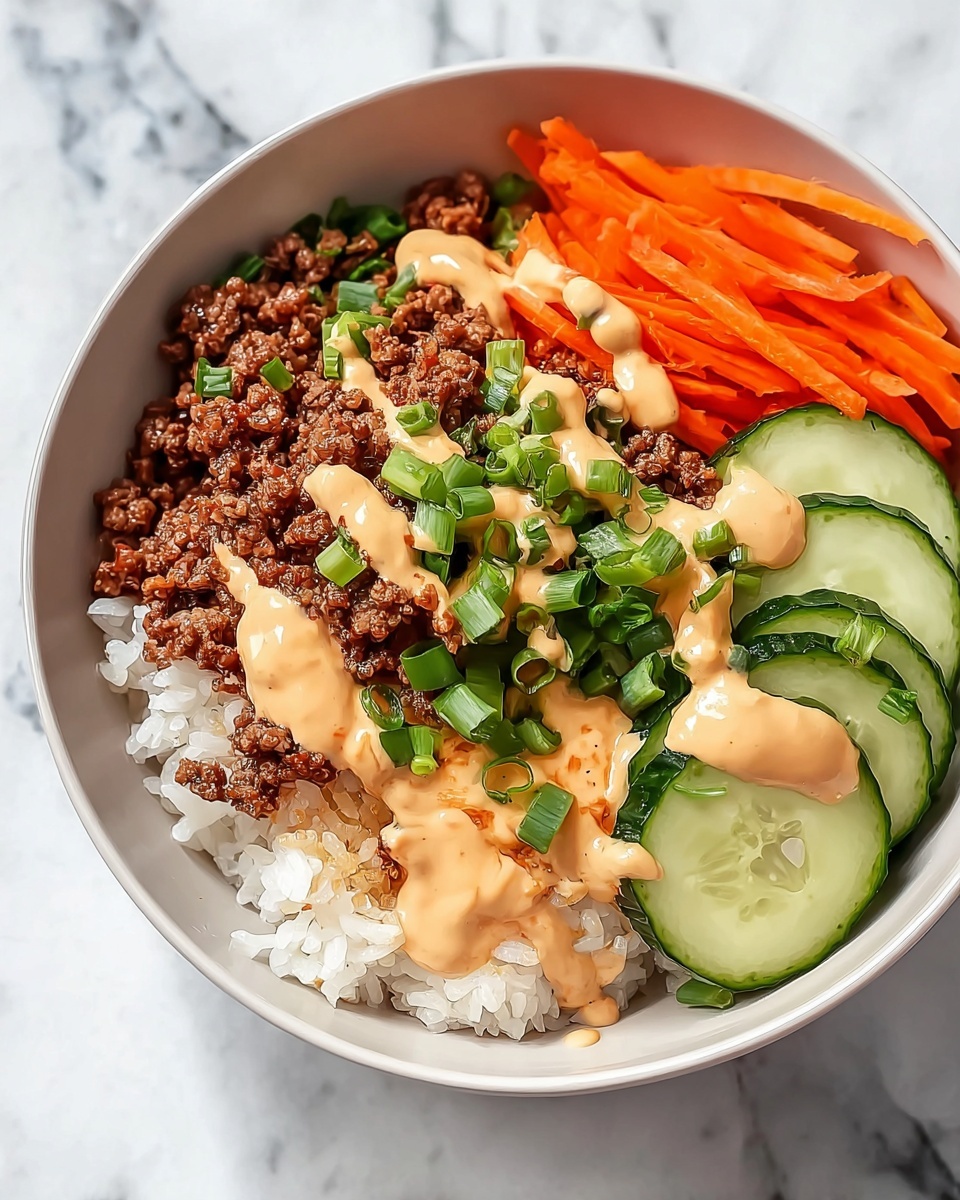If you’re craving something bursting with flavor, texture, and a touch of spice, this Korean Beef Rice Bowls Recipe is exactly what you need to try next. It combines juicy, umami-packed minced beef with the fresh crunch of vegetables, all tied together with a mouthwatering sauce that balances sweetness, heat, and tang perfectly. Preparing this dish is a breeze, making it a fabulous weeknight dinner or a meal to impress guests without hours in the kitchen. Get ready to dive into a bowl full of vibrant tastes that always bring everyone back for seconds!

Ingredients You’ll Need
Each ingredient in this Korean Beef Rice Bowls Recipe plays a crucial role in building layers of taste and texture, from savory and spicy to fresh and crisp. Keeping the ingredient list straightforward ensures a stress-free cooking experience without compromising on flavor.
- Freshly grated garlic (1 tsp): Adds aromatic pungency that wakes up the palate instantly.
- Freshly grated ginger (1 tsp): Brings a zesty, slightly peppery warmth that complements the beef beautifully.
- All-purpose soy sauce (3 tbsp): Provides savory depth and a rich umami base for the marinade.
- Brown sugar (2 tbsp): Balances the saltiness with subtle caramel sweetness for a harmonious sauce.
- Sesame oil (1 tbsp plus ½ tsp): Contributes a toasty, nutty aroma that’s signature to Korean flavors.
- Gochujang (1 tbsp plus 1 tsp): This spicy red chili paste adds fiery heat with a hint of sweetness—adjust according to your spice preference.
- Rice vinegar (1 tsp plus ½ tsp): Adds bright acidity for balance, cutting through the rich beef nicely.
- Sesame seeds (1 tbsp plus extra): Give a textural crunch and a lovely nutty finish as garnish.
- Extra-virgin olive oil or neutral oil (2 tbsp): Used for cooking the beef to a perfectly browned, juicy state.
- Minced (ground) beef (500 g / 1 lb 2 oz): The hearty, protein-rich star of this dish, making it satisfyingly filling.
- Spring onions (2, finely sliced): Add fresh, sharp onion notes and a pop of color—reserve 1 tbsp for garnish.
- Whole-egg mayonnaise (3 tbsp): Forms the creamy base of the spicy mayo dressing adding richness.
- Cooked jasmine rice (2 cups / 370 g): Steamy, fragrant rice that soaks up all the delicious sauces and toppings.
- Kimchi (1 cup / 240 g): Fermented cabbage that brings a tangy, spicy punch and probiotics.
- Carrot (1, julienned): Offers a crisp, sweet crunch and vibrant orange color.
- Lebanese cucumber (1, sliced into half moons): Cools the palate and adds freshness with every bite.
How to Make Korean Beef Rice Bowls Recipe
Step 1: Prepare the Spicy Mayo
Start by whisking together the whole-egg mayonnaise, 1 teaspoon of gochujang, ½ teaspoon of sesame oil, and ½ teaspoon of rice vinegar in a small bowl. This spicy mayo will add a creamy, tangy kick that perfectly contrasts the savory beef later on.
Step 2: Cook the Beef
Heat 2 tablespoons of olive or neutral oil in a large frying pan over medium-high heat. Add the freshly grated garlic and ginger, cooking briefly until fragrant but not browned. Then add the minced beef, breaking it up with a wooden spoon, and cook until it’s nicely browned and cooked through.
Step 3: Make the Korean Beef Sauce
Once the beef is cooked, stir in 3 tablespoons of soy sauce, 2 tablespoons of brown sugar, 1 tablespoon of sesame oil, 1 tablespoon of gochujang, and 1 teaspoon of rice vinegar. Cook everything for another 2-3 minutes until the sauce thickens and coats the beef beautifully. Finish by sprinkling in 1 tablespoon of sesame seeds and the finely sliced spring onions (except the reserved tablespoon for garnish).
Step 4: Assemble the Bowls
Divide the warm cooked jasmine rice evenly into four large bowls. Spoon generous portions of the spicy Korean beef mixture over the rice. Arrange julienned carrot, sliced Lebanese cucumber, and kimchi on the side or on top for a perfect balance of cool crunch and tangy spice.
How to Serve Korean Beef Rice Bowls Recipe

Garnishes
For the finishing touches, drizzle the spicy mayo over each bowl in a zigzag pattern. Sprinkle extra sesame seeds and the reserved spring onion slices on top to add visual appeal and an extra burst of flavor. These garnishes bring both freshness and a playful texture that makes the dish even more enjoyable.
Side Dishes
This Korean Beef Rice Bowls Recipe pairs wonderfully with light sides like a crisp cucumber salad or steamed edamame. For a warming contrast, try serving it alongside miso soup or a simple bowl of steamed greens tossed with sesame oil and garlic.
Creative Ways to Present
Looking to impress at your next gathering? Serve the beef bowls in individual mini cast iron skillets or rustic wooden bowls. Layering the kimchi and vegetables on top adds a colorful, Instagram-worthy touch. You might also offer extra gochujang and spicy mayo on the side so everyone can customize their bowls to their liking.
Make Ahead and Storage
Storing Leftovers
If you have leftovers, cool them to room temperature, then store the beef mixture and rice separately in airtight containers. This helps maintain the best texture and prevents the rice from becoming soggy. The components will stay fresh for up to 3 days in the fridge.
Freezing
The cooked beef sauce freezes well if placed in a freezer-safe container, but do not freeze the rice or fresh vegetables as they can lose texture. When ready to enjoy, thaw the beef overnight in the fridge for the best results.
Reheating
Reheat the beef mixture gently in a pan over medium heat or in the microwave until warmed through. Warm the rice separately and briefly steam or refresh the vegetables before assembling your bowl again to bring back that fresh crunch.
FAQs
Can I use ground turkey or chicken instead of beef?
Absolutely! Substituting ground turkey or chicken is a great way to lighten this Korean Beef Rice Bowls Recipe while keeping the vibrant flavors intact. Just adjust cooking time as needed.
What if I don’t have gochujang?
If gochujang is unavailable, you can substitute it with a mix of sriracha and a little miso paste or even chili garlic sauce to get a similar flavor profile, though the unique fermented sweetness will be less pronounced.
Is this dish spicy?
It has a medium level of heat, thanks to gochujang and the spicy mayo, but you can easily adjust the spice by adding more or less gochujang or serving extra spicy mayo on the side.
Can I make this recipe gluten-free?
Yes! Just be sure to use gluten-free soy sauce or tamari, and check that all other ingredients, including gochujang, are certified gluten-free to keep the dish safe for gluten-sensitive eaters.
How long does this dish take to make?
The entire Korean Beef Rice Bowls Recipe comes together in about 20 minutes, making it a fantastic option for a quick yet satisfying meal anytime you’re short on time but crave big flavors.
Final Thoughts
This Korean Beef Rice Bowls Recipe has stolen my heart with its perfect balance of bold, comforting, and fresh flavors, and I’m confident it will do the same for you. It’s quick, easy, and endlessly customizable, making it a standout addition to your weeknight dinner lineup. Give this delicious bowl a try and watch how quickly it becomes a favorite in your home!
Print
Korean Beef Rice Bowls Recipe
- Prep Time: 5 minutes
- Cook Time: 15 minutes
- Total Time: 20 minutes
- Yield: 4 servings
- Category: Main Dish
- Method: Stovetop
- Cuisine: Korean
Description
A quick and flavorful Korean Beef Rice Bowl recipe that combines tender ground beef cooked in a savory and mildly spicy sauce with fresh vegetables, kimchi, and a creamy gochujang mayo. Perfect for an easy weeknight dinner, this dish offers a delicious balance of sweet, spicy, and umami flavors served over fluffy jasmine rice.
Ingredients
Beef Marinade and Sauce
- 1 tsp freshly grated garlic
- 1 tsp freshly grated ginger
- 3 tbsp all-purpose soy sauce
- 2 tbsp brown sugar
- 1 tbsp sesame oil
- 1 tbsp gochujang (adjust for spice preference)
- 1 tsp rice vinegar
- 1 tbsp sesame seeds, plus extra to garnish
Beef and Garnish
- 2 tbsp extra-virgin olive oil or neutral oil
- 500 g (1 lb 2 oz) minced (ground) beef
- 2 spring onions (scallions), finely sliced (1 tbsp reserved for garnish)
Gochujang Mayonnaise
- 3 tbsp whole-egg mayonnaise
- 1 tsp gochujang
- ½ tsp sesame oil
- ½ tsp rice vinegar
Vegetables and Rice
- 2 cups (370 g) cooked jasmine rice
- 1 cup (240 g) kimchi
- 1 carrot, julienned
- 1 Lebanese (short) cucumber, sliced into half moons
Instructions
- Prepare the sauce: In a medium bowl, combine freshly grated garlic, grated ginger, soy sauce, brown sugar, sesame oil, gochujang, rice vinegar, and sesame seeds. Stir well until the sugar is dissolved and set aside.
- Cook the beef: Heat the olive oil in a large skillet over medium-high heat. Add the ground beef and cook, breaking it apart with a spatula, until browned and cooked through, about 6-8 minutes.
- Add the sauce and scallions: Pour the prepared sauce over the cooked beef, add the finely sliced spring onions, and stir well to coat the meat evenly. Cook for an additional 2-3 minutes until the sauce thickens slightly and the beef is well flavored. Remove from heat.
- Make the gochujang mayo: In a small bowl, mix together the mayonnaise, gochujang, sesame oil, and rice vinegar until smooth and creamy.
- Assemble the bowls: Divide the cooked jasmine rice evenly among four serving bowls. Top each with the cooked Korean beef mixture.
- Add the vegetables and kimchi: Arrange julienned carrot, sliced cucumber, and kimchi around the beef in each bowl for a fresh and crunchy contrast.
- Garnish and serve: Drizzle the gochujang mayo over the bowls and sprinkle additional sesame seeds and reserved sliced spring onions on top. Serve immediately and enjoy your flavorful Korean Beef Rice Bowls.
Notes
- To adjust spiciness, reduce or omit the gochujang or substitute with a mild chili paste or sweet chili sauce.
- You can substitute ground beef with ground turkey or chicken for a lighter version.
- Use short grain rice instead of jasmine if preferred for a stickier texture.
- Kimchi can be replaced with pickled vegetables if unavailable.
- Store leftovers in an airtight container in the refrigerator for up to 3 days.








